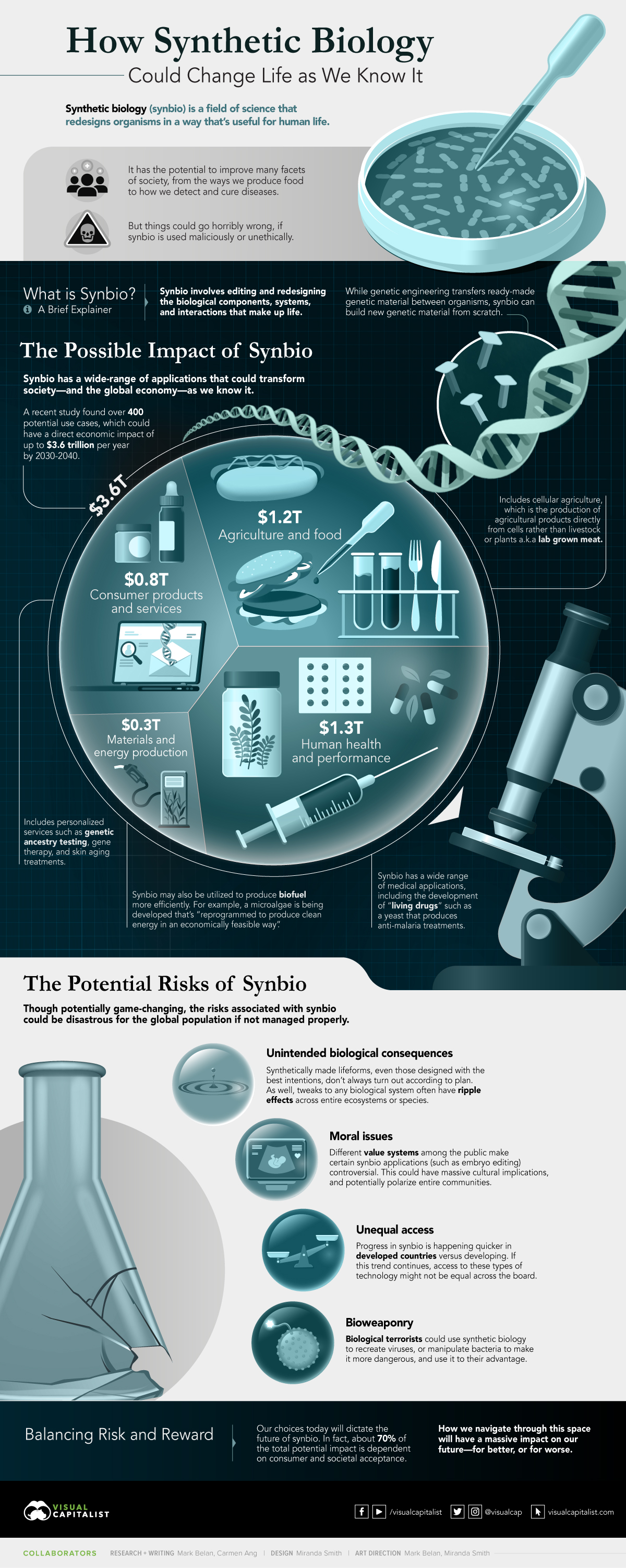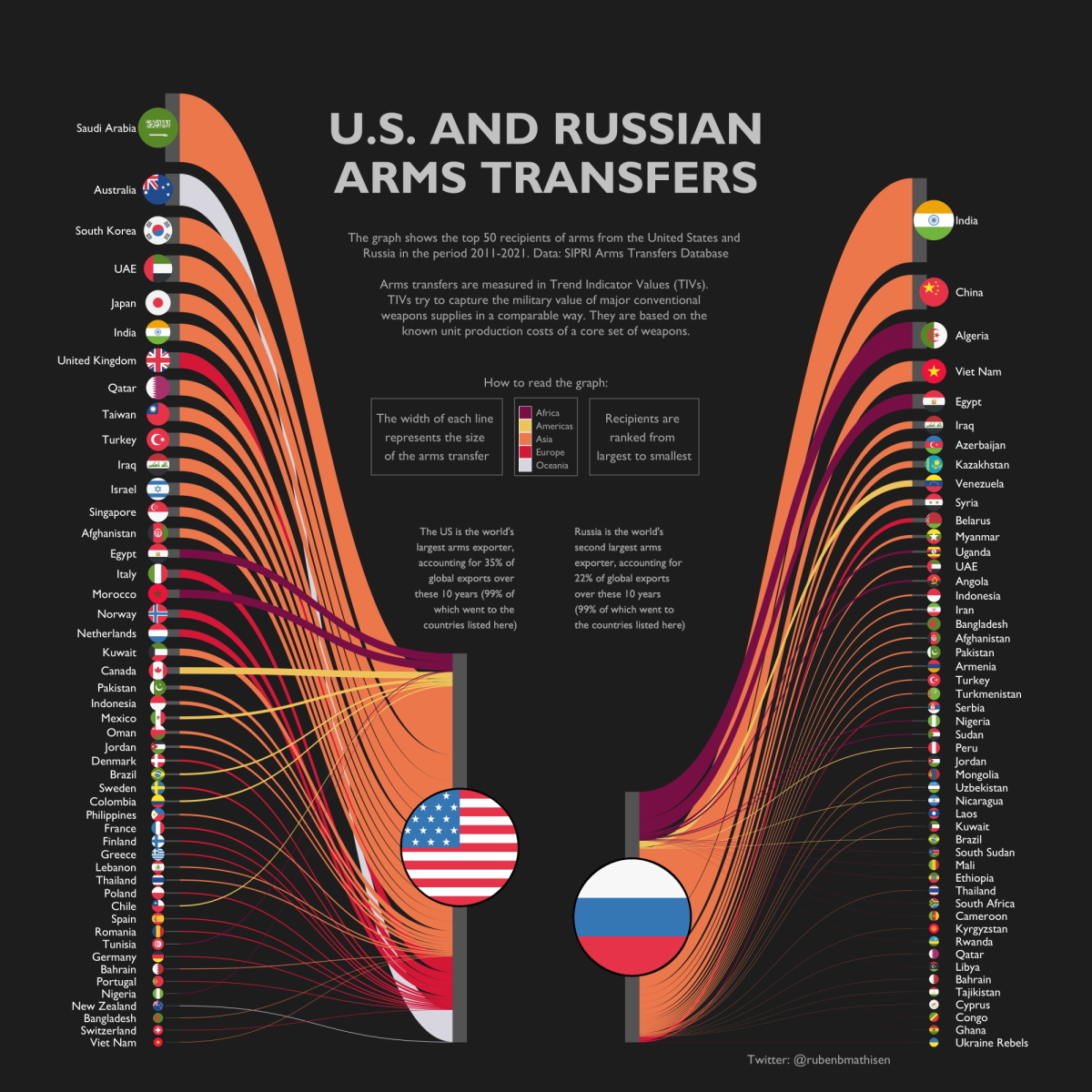Visual Capitalist |
| Synthetic Biology: The $3.6 Trillion Science Changing Life as We Know It Posted: 10 May 2022 11:38 AM PDT
How Synthetic Biology Could Change Life as we Know itSynthetic biology (synbio) is a field of science that redesigns organisms in an effort to enhance and support human life. According to one projection, this rapidly growing field of science is expected to reach $28.8 billion in global revenue by 2026. Although it has the potential to transform many aspects of society, things could go horribly wrong if synbio is used for malicious or unethical reasons. This infographic explores the opportunities and potential risks that this budding field of science has to offer. What is Synthetic Biology?We've covered the basics of synbio in previous work, but as a refresher, here's a quick explanation of what synbio is and how it works. Synbio is an area of scientific research that involves editing and redesigning different biological components and systems in various organisms. It's like genetic engineering but done at a more granular level—while genetic engineering transfers ready-made genetic material between organisms, synbio can build new genetic material from scratch. The Opportunities of SynbioThis field of science has a plethora of real-world applications that could transform our everyday lives. A study by McKinsey found over 400 potential uses for synbio, which were broken down into four main categories:
If those potential uses become reality in the coming years, they could have a direct economic impact of up to $3.6 trillion per year by 2030-2040. 1. Human Health and PerformanceThe medical and health sector is predicted to be significantly influenced by synbio, with an economic impact of up to $1.3 trillion each year by 2030-2040. Synbio has a wide range of medical applications. For instance, it can be used to manipulate biological pathways in yeast to produce an anti-malaria treatment. It could also enhance gene therapy. Using synbio techniques, the British biotech company Touchlight Genetics is working on a way to build synthetic DNA without the use of bacteria, which would be a game-changer for the field of gene therapy. 2. Agriculture and FoodSynbio has the potential to make a big splash in the agricultural sector as well—up to $1.2 trillion per year by as early as 2030. One example of this is synbio's role in cellular agriculture, which is when meat is created from cells directly. The cost of creating lab-grown meat has decreased significantly in recent years, and because of this, various startups around the world are beginning to develop a variety of cell-based meat products. 3. Consumer Products and ServicesUsing synthetic biology, products could be tailored to suit an individual’s unique needs. This would be useful in fields such as genetic ancestry testing, gene therapy, and age-related skin procedures. By 2030-2040, synthetic biology could have an economic impact on consumer products and services to the tune of up to $800 billion per year. 4. Materials and Energy ProductionSynbio could also be used to boost efficiency in clean energy and biofuel production. For instance, microalgae are currently being "reprogrammed" to produce clean energy in an economically feasible way. This, along with other material and energy improvements through synbio methods, could have a direct economic impact of up to $300 billion each year. The Potential Risks of SynbioWhile the potential economic and societal benefits of synthetic biology are vast, there are a number of risks to be aware of as well:
According to a group of scientists at the University of Edinburgh, communication between the public, synthetic biologists, and political decision-makers is crucial so that these societal and environmental risks can be mitigated. Balancing Risk and RewardDespite the risks involved, innovation in synbio is happening at a rapid pace. By 2030, most people will have likely eaten, worn, or been treated by a product created by synthetic biology, according to synthetic biologist Christopher A. Voigt. Our choices today will dictate the future of synbio, and how we navigate through this space will have a massive impact on our future—for better, or for worse. The post Synthetic Biology: The $3.6 Trillion Science Changing Life as We Know It appeared first on Visual Capitalist. | ||||||||||||||||||||||||||||||||||||||||||||||||||||||||||||||||||||||||||||||||||||||||||||||||||||||||||||||||||||||||||||||||||||||||||||||||||||||||||||||||||||||||||||||||||||||||||||||||||||||||||||||||||||||||||||||||||||||||||||||||||||||||||||||||||||||||||||||||||||||||||||||||||||||||||||||||||
| Arms Transfers: U.S. and Russia’s Biggest Trading Partners Posted: 09 May 2022 07:39 AM PDT
Arms Transfers: U.S. and Russia's Biggest Trading PartnersThe increase in conflicts worldwide, including in Ukraine and the Middle East, has shifted global focus back onto arms transfers between countries. For decades, countries proficient in arms manufacturing have supplied weapons to other countries in demand of them. At the helm of these trades are the U.S. and Russia, which have accounted for 57% of all international arms trades in the last 10 years. So who are the largest importers of arms from these two countries, and what is the military value of these trades? With the help of data from the Stockholm International Peace Research Institute (SIPRI) arms transfer database, the above infographic by Ruben Berge Mathisen visualizes the top 50 biggest arms recipients by value for both the U.S. and Russia in the last decade. The Military Valuation of Arms TransfersThe military valuation of arms is measured in terms of trend-indicator values (TIV). This valuation reflects the military capability of a particular item rather than its financial value. Every weapon that falls under the conventional definition of major arms is allotted a TIV. The following are the most common weapons and components to be assigned a TIV.
Instead of focusing on budget, examining TIV makes it easier to measure trends in the flow of arms between particular countries and regions over time, essentially creating a military capability price index. Biggest Recipients of U.S. ArmamentsThe United States is the largest exporter of arms globally, responsible for 35% of global exports over the last 10 years to about 130 nations. Most recently, the biggest market for U.S. arms sales has been in the Middle East, with Saudi Arabia being the most prominent recipient of weapons. Over the last decade, the country has purchased 24% of total U.S. arms exports, with components worth over 18 billion TIVs. Here is a look at the top 50 recipients of arms from the United States:
The U.S. remains the biggest global exporter of weapons globally, however, sales of military equipment to foreign countries dipped by 21% over the previous fiscal year, dropping from $175 billion in 2020 to $138 billion in 2021. Biggest Recipients of Russian ArmamentsRussia, the world’s second-largest arms dealer, was responsible for 22% of global arms exports between 2011 and 2021. In terms of TIVs, India remains the biggest importer of Russian weapons by a wide margin. India's dependency on Russian-made arms is driven by its fight to quell the military assertiveness of China on one side and its constant skirmishes along the Pakistani border on the other. But despite the continued support of Russia and its President by the Indian Prime Minister, even in the wake of Russia's war on Ukraine, some reports have shown that India has been looking elsewhere for arms in the last few years. Let's take a look at some of the other biggest importers of Russian arms around the world:
One relationship of significance is Russia's provided weapons to Pro-Russia Ukrainian Rebels. Since 2014, Russia has offered arms and training to these rebels in their fight. These have included weapons of all sorts, from pistols and mines to tanks and missile launchers. Effect of the War on Ukraine on Arms TradesAccording to the latest data from SIPRI, the international arms trade fell by 4.6% in the last five-year period. Despite this, Europe has become a new hotspot for arms imports, seeing a 19% increase in arms transfers over the same time period. Countries like the U.K., Netherlands, and Norway were the largest importers, and other countries might follow suit. Experts claim that this upsurge is attributed to the crumbling relationship between Russia and Europe. Alarmed by Russia's invasion of Ukraine, European countries have been reevaluating their defense budgets—as exemplified by Germany’s recent €100 billion commitment to boost its military strength. In the coming years, the U.S. and Russia’s biggest arms transfer partners are likely to shift. But which way will arms transfers trend? The post Arms Transfers: U.S. and Russia's Biggest Trading Partners appeared first on Visual Capitalist. |
| You are subscribed to email updates from Visual Capitalist. To stop receiving these emails, you may unsubscribe now. | Email delivery powered by Google |
| Google, 1600 Amphitheatre Parkway, Mountain View, CA 94043, United States | |





 Saudi Arabia
Saudi Arabia Australia
Australia South Korea
South Korea UAE
UAE Japan
Japan India
India United Kingdom
United Kingdom Qatar
Qatar Taiwan
Taiwan Turkey
Turkey Iraq
Iraq Israel
Israel Singapore
Singapore Afghanistan
Afghanistan Egypt
Egypt Italy
Italy Morocco
Morocco Norway
Norway Netherlands
Netherlands Kuwait
Kuwait Canada
Canada Pakistan
Pakistan Indonesia
Indonesia Mexico
Mexico Oman
Oman Jordan
Jordan Denmark
Denmark Brazil
Brazil Sweden
Sweden Colombia
Colombia Philippines
Philippines France
France Finland
Finland Greece
Greece Lebanon
Lebanon Thailand
Thailand Poland
Poland Chile
Chile Spain
Spain Romania
Romania Tunisia
Tunisia Germany
Germany Bahrain
Bahrain Portugal
Portugal Nigeria
Nigeria New Zealand
New Zealand Bangladesh
Bangladesh Switzerland
Switzerland Vietnam
Vietnam Argentina
Argentina China
China Algeria
Algeria Azerbaijan
Azerbaijan Kazakhstan
Kazakhstan Venezuela
Venezuela Syria
Syria Belarus
Belarus Myanmar
Myanmar Uganda
Uganda Angola
Angola Iran
Iran Armenia
Armenia Turkmenistan
Turkmenistan Serbia
Serbia Sudan
Sudan Peru
Peru Mongolia
Mongolia Uzbekistan
Uzbekistan Nicaragua
Nicaragua Laos
Laos South Sudan
South Sudan Mali
Mali Ethiopia
Ethiopia South Africa
South Africa Cameroon
Cameroon Kyrgyzstan
Kyrgyzstan Rwanda
Rwanda Libya
Libya Tajikistan
Tajikistan Cyprus
Cyprus Republic of the Congo
Republic of the Congo Ghana
Ghana Ukraine Rebels
Ukraine Rebels
No comments:
Post a Comment